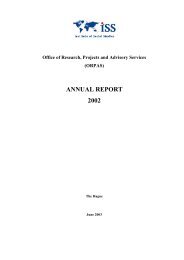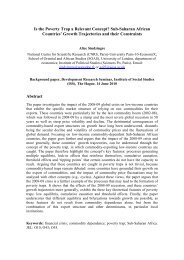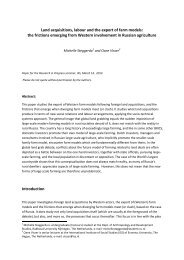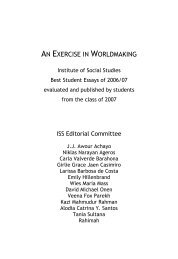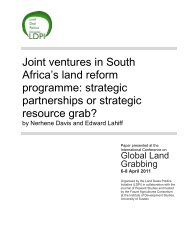AN EXERCISE IN WORLDMAKING 2009 - ISS
AN EXERCISE IN WORLDMAKING 2009 - ISS
AN EXERCISE IN WORLDMAKING 2009 - ISS
Create successful ePaper yourself
Turn your PDF publications into a flip-book with our unique Google optimized e-Paper software.
36 JONATH<strong>AN</strong> CONNOR<br />
2002: 297). In turn, the success of these participatory initiatives and the<br />
growing incidence of successful indigenous organization drew the attention<br />
of (new) external actors and development schemes. Therefore, the<br />
emergence of participatory local governance in Guamote cannot be<br />
solely attributed to popular mobilization nor to external interventions by<br />
state and civil society actors; both appear to be crucial variables in the<br />
canton’s transformation. A third factor that merits brief mention here is<br />
the notion of economic marginality. As Cameron (2003: 183) notes, “It is<br />
no coincidence that participatory processes emerged and indigenous and<br />
peasant mayors were elected in some of the poorest cantons in highland<br />
Ecuador”. Guamote did not possess oil, gas and minerals, nor was it a<br />
large agro-export county. In this sense, the canton was “marginal to the<br />
interests of capital” (Bebbington, 2007: 72). Had there been more lucrative<br />
economic opportunities in the region, powerful economic actors<br />
would have certainly resisted political and economic restructuring that<br />
challenged their power and threatened their interests in the municipality.<br />
The transformations outlined in this paper represent one the most innovative<br />
cases of local governance in Ecuador. However, Guamote’s<br />
success is not without limit. Problems of exclusion and representation<br />
have not disappeared completely. Given the centrality of indigenouspeasant<br />
identities to Guamote’s OSGs and local development initiatives,<br />
there is a danger of marginalizing the canton’s non-indigenous and nonpeasant<br />
members. Similarly, there has been a noticeable underrepresentation<br />
of women in local initiatives. For example, Cameron (2003) has<br />
noted the “extremely low representation of women” in Guamote’s Indigenous<br />
and Popular Parliament. Despite legislation to increase female<br />
candidacy for political office, women tend to be elected to “the lowerranking<br />
posts with less control over budgets and management” (Radcliffe<br />
et al., 2002: 300). It should be noted, however, that these tendencies<br />
are much more pronounced at the provincial and state level, and<br />
there is growing evidence that municipalities such as Guamote are overcoming<br />
gender imbalances.<br />
A more pressing issue in Guamote is the relative absence of economic<br />
development. Despite dynamic changes in the canton’s political organization,<br />
economic growth has been slow and is much less obvious. Income<br />
remains extremely low, with all three of Guamote’s parishes exhibiting<br />
“poverty rates of near or above 90 percent of the population”<br />
(Bebbington, 2000: 507). For many, agricultural production continues to




